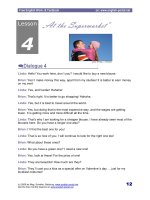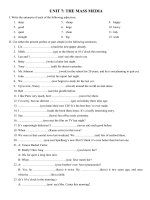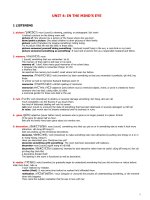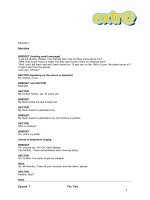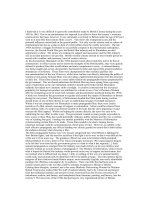4 7 the mexican american war
Bạn đang xem bản rút gọn của tài liệu. Xem và tải ngay bản đầy đủ của tài liệu tại đây (2.5 MB, 10 trang )
Fascinating Facts
• United States soldiers took the same route
The
Mexican-American War
that Spanish explorer Hernando Cortés and
his men had taken more than three hundred
years before to defeat the Aztec Empire.
• Zachary Taylor was not the only President who
served in the Mexican War. Ulysses S. Grant and
Franklin Pierce also served in that war.
• After the Mexican War, many people in Latin
America called the United States “El Coloso
del Norte,” or the colossus of the North.
Genre
Nonfiction
Comprehension Skill
Compare and
Contrast
Text Features
• Map
• Chart
• Captions
Scott Foresman Social Studies
ISBN 0-328-14861-X
ì<(sk$m)=beigbf< +^-Ä-U-Ä-U
by Rena Korb
In this book you will read about the MexicanAmerican War, which was fought in 1846 and
1847. The United States’ victory gave the country
more than half a million square miles of land
that stretched from the Atlantic Ocean to the
Pacific Ocean.
The
Mexican-American War
Write to It!
The United States won every battle in
the Mexican War. Choose one of those
battles and write a description of it. Be
sure to include important details, such
as where and when it was fought and
how it was won.
Vocabulary
boundary
Write your description on a separate
sheet of paper.
province
annex
manifest destiny
rebellion
negotiations
Maps
MapQuest, Inc.
by Rena Korb
Photographs
Every effort has been made to secure permission and provide appropriate credit for photographic material. The publisher deeply
regrets any omission and pledges to correct errors called to its attention in subsequent editions.
Unless otherwise acknowledged, all photographs are the property of Scott Foresman, a division of Pearson Education.
Photo locators denoted as follows: Top (T), Center (C), Bottom (B), Left (L), Right (R) Background (Bkgd)
ISBN: 0-328-14861-X
Copyright © Pearson Education, Inc.
All Rights Reserved. Printed in the United States of America. This publication is protected
by Copyright, and permission should be obtained from the publisher prior to any prohibited
reproduction, storage in a retrieval system, or transmission in any form by any means,
electronic, mechanical, photocopying, recording, or likewise. For information regarding
permission(s), write to: Permissions Department, Scott Foresman, 1900 East Lake Avenue,
Glenview, Illinois 60025.
1 2 3 4 5 6 7 8 9 10 V0G1 14 13 12 11 10 09 08 07 06 05
Opener: ©North Wind Picture Archives
2 ©Corbis
3 ©North Wind Picture Archives
6 ©North Wind Picture Archives
7 ©The Granger Collection,
NY
Editorial
Offices: Glenview, Illinois • Parsippany, New Jersey • New York, New York
8 North Wind Picture Archives
9 ©Getty Images
Sales Offices: Needham, Massachusetts • Duluth, Georgia • Glenview, Illinois
10 ©Getty Images
Coppell, Texas • Sacramento, California • Mesa, Arizona
12 ©Getty Images
14 ©National Archives
Causes of the War
During Polk’s presidency,
the United States gained
the right to more land.
This land later became
the states of Oregon and
Washington.
Buildup to War
In the spring of 1846, Mexican armies and United
States troops had gathered on opposite sides of the Rio
Grande in Texas. The United States claimed that the
boundary, or border, between the two countries was the
Rio Grande. Mexico disagreed.
Mexican soldiers crossed the river and attacked a group
of United States soldiers on April 25. On May 13, 1846,
the United States declared war against Mexico.
2
To understand the causes of the Mexican War, it is
important to look at earlier events. Mexico had won
its independence from Spain in 1821. Some of the
Spanish colonies in North America became the Mexican
provinces of New Mexico, California, and Texas. Then
settlers from the United States and others who lived
in Texas fought Mexican forces and created their own
country. When the United States annexed Texas in
1845, the Mexican government was angry. The United
States wanted Texas and all the land west to the Pacific
Ocean. The idea that the United States should stretch from
coast to coast was known as manifest destiny.
At the end of March 1846,
General Zachary Taylor’s
troops began building forts
along the Rio Grande.
3
Objections to the War
The Capture of New Mexico
Not all Americans supported the war with Mexico.
Some United States senators believed that the boundary
between the two countries was the Nueces River, not the
Rio Grande. Also, many people who opposed slavery
disliked the war.
In June 1846 Colonel Stephen Kearney led about 1,500
troops toward New Mexico’s capital, Santa Fe. Kearney
claimed the towns they passed along the way. On
August 18, the troops reached Santa Fe. Kearney raised
the American flag and announced that the United States
was annexing New Mexico.
In 1845 the United States tried to buy the Mexican
land. John Slidell went to Mexico to offer up to $30
million for the purchase of the provinces of New Mexico
and California. The Mexican government refused to see
Slidell. There seemed little chance of getting the land
other than taking it by force. After the battle between the
two armies at the Rio Grande, the United States had a
reason to go to war.
4
Advantages in Fighting the Mexican War
American Advantages
Mexican Advantages
•
Better weapons
•
•
Better military
leaders
•
•
Better-trained
soldiers
•
5
Three times
more soldiers
Possible aid from
Great Britain
and France
Disapproval of
the war by many
Americans
Most New Mexicans accepted United States rule.
However, a group of New Mexicans and Pueblo Indians
started a rebellion. The United States army chased the
rebels, and the rebels surrendered. New Mexico was now
under the control of the United States.
The Bear Flag Revolt was named for the flag the American
settlers made that pictured a grizzly bear.
Colonel Stephen Kearney captured New Mexico from Mexico.
The Bear Flag Revolt
By the summer of 1846, fighting also had broken out in
California. California’s non-American Indian populations
numbered about eight thousand Mexicans, called
Californios, and five hundred other settlers.
On June 14, a small group of settlers in Sonoma
arrested the Mexican army commander and captured
military weapons. Then they wrote their declaration of
independence from Mexico. They named California the
Bear Flag Republic.
7
The War in Mexico
While some United States troops were fighting in the
northern provinces, others invaded Mexico. General
Taylor earned his first major victory on May 18, 1846.
He captured the town of Matamoros on the other side of
the Rio Grande. Taylor then raised the American flag over
the town.
United States troops held off a Mexican attack in the Battle of
San Gabriel in California.
The Capture of California
United States Navy troops landed on the coast in July.
Soldiers took over land held by the Californios. After
about a month, United States forces thought they had
control of California. However, the Californios rebelled
and by mid-December had regained most of southern
California. About that time, Colonel Kearney and his army
arrived in San Diego. They marched toward Los Angeles
and put down the rebellion in January. The United States
had captured California.
8
Before he crossed the Rio Grande, General Taylor had led his troops into
several successful battles against the Mexican army.
9
The Battles of Monterrey
and Buena Vista
In September 1846, Taylor led his soldiers to Monterrey.
Monterrey was guarded by several hills that had forts
on top of them. United States troops captured the forts
and entered the city. After several days of fighting, the
Mexicans gave up.
The battle for Monterrey had weakened both armies.
The armies agreed to stop fighting for eight weeks. In
January 1847, a force of about twenty thousand Mexican
troops tried to retake Monterrey. When Taylor learned
of the planned attack, he led his five thousand men to
nearby Buena Vista. After a few days of hard fighting,
neither side appeared close to a victory. American troops
expected another fierce struggle on the third morning of
the Battle of Buena Vista. To their surprise, they awoke to
find the Mexican troops had gone.
United States troops scrambled
up the hills of Monterrey.
11
Today, Mexicans remember several cadets who fought at
Chapultepec as los Niños Héroes, or “the Boy Heroes.”
The Capture of Veracruz
The Capture of Mexico City
Many U.S. military leaders believed they needed
to capture Mexico City. About ten thousand American
troops landed on the coast near the city of Veracruz.
They blasted the city with cannonballs. Mexican soldiers
returned fire. Within a few days, the cannonballs had
blown a hole in the town wall. The city fell to American
troops on March 27, 1847.
One week later, American soldiers began the long
march to Mexico City. They defeated all the Mexican
forces that tried to stop them. They attacked an old
castle that was used as a Mexican military school. On
September 14, 1847, United States forces entered
Mexico City.
12
13
The Treaty of
Guadalupe Hidalgo
United States Expansion in the
Southwest
The Mexican War ended with the fall of Mexico City.
All that remained was setting the terms of peace. Nicholas
Trist began negotiations with the Mexican government.
Trist and the Mexican leaders agreed to the Treaty
of Guadalupe Hidalgo. Mexico gave up its northern
provinces. In return the United States paid Mexico
$15 million.
The United States gained more than half a million
square miles of land as a result of the Mexican War.
This included lands that today make up California,
New Mexico, Nevada, Arizona, Utah, Wyoming,
CANADA
MEXICAN CESSION
1848
PACIFIC
OCEAN
Present-day
boundaries
are shown.
GADSDEN
PURCHASE
1853
UNITED STATES
ATLANTIC
OCEAN
TEXAS
1845
N
Gulf of Mexico
0
0
The land that the United
States gained from the
Treaty of Guadalupe
Hidalgo is known as
the Mexican Cession.
14
200
400 Miles
MEXICO
200
400 Kilometers
and Colorado. In 1853 the United States paid $10 million
to Mexico for more land in the Southwest known as
the Gadsden Purchase.
Life in the new territory soon changed. Thousands
of Mexicans became United States citizens. American
settlement grew, especially after gold was discovered in
California in 1848. The country finally stretched from the
Atlantic Ocean to the Pacific Ocean.
15
In this
book you will read about the MexicanGlossary
American War, which was fought in 1846 and
annex
to add States’
or attach
1847.
The United
victory gave the country
more
than half a line
million
square miles
of that
land
boundary
or natural
feature
that stretched
the Atlantic
to the
separatesfrom
one area
or stateOcean
from another
Pacific Ocean.
manifest destiny the belief that the
United States should expand west to the
Pacific OceanVocabulary
Write to It!
The United States won every battle in
the Mexican War. Choose one of those
battles and write a description of it. Be
sure to include important details, such
as where and when it was fought and
how it was won.
negotiations the
process of working with
boundary
others to come to an agreement on an issue
province
province a territory governed by a country
annex
or empire
manifest destiny
rebellion open and armed resistance to
a government rebellion
negotiations
Write your description on a separate
sheet of paper.
Maps
MapQuest, Inc.
Photographs
Every effort has been made to secure permission and provide appropriate credit for photographic material. The publisher deeply
regrets any omission and pledges to correct errors called to its attention in subsequent editions.
Unless otherwise acknowledged, all photographs are the property of Scott Foresman, a division of Pearson Education.
Photo locators denoted as follows: Top (T), Center (C), Bottom (B), Left (L), Right (R) Background (Bkgd)
ISBN: 0-328-14861-X
Copyright © Pearson Education, Inc.
All Rights Reserved. Printed in the United States of America. This publication is protected
by Copyright, and permission should be obtained from the publisher prior to any prohibited
reproduction, storage in a retrieval system, or transmission in any form by any means,
electronic, mechanical, photocopying, recording, or likewise. For information regarding
permission(s), write to: Permissions Department, Scott Foresman, 1900 East Lake Avenue,
Glenview, Illinois 60025.
1 2 3 4 5 6 7 8 9 10 V0G1 14 13 12 11 10 09 08 07 06 0516
Opener: ©North Wind Picture Archives
2 ©Corbis
3 ©North Wind Picture Archives
6 ©North Wind Picture Archives
7 ©The Granger Collection, NY
8 North Wind Picture Archives
9 ©Getty Images
10 ©Getty Images
12 ©Getty Images
14 ©National Archives

